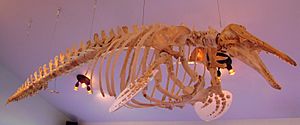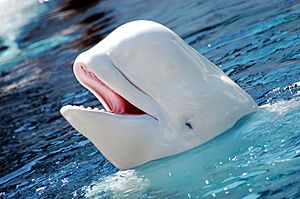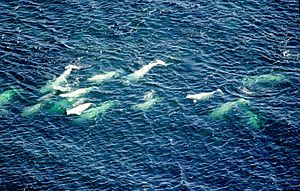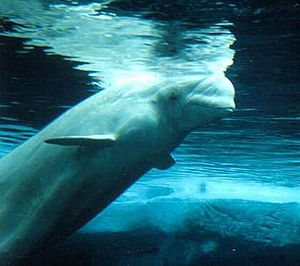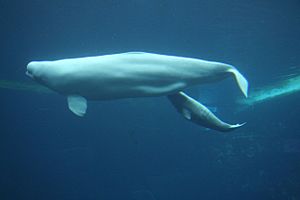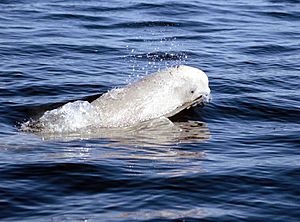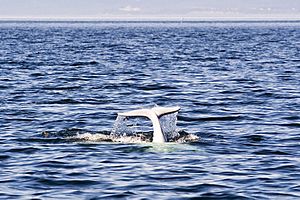Beluga whale facts for kids
Quick facts for kids Beluga whale |
|
|---|---|
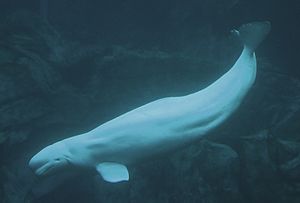 |
|
| At Georgia Aquarium | |
 |
|
| Size compared to an average human | |
| Conservation status | |
| Scientific classification | |
| Genus: |
Delphinapterus
|
| Species: |
leucas
|
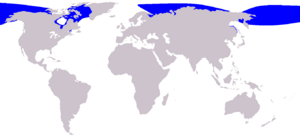 |
|
| Beluga range | |
The beluga whale (Delphinapterus leucas) is a small, white whale with teeth. You can find them in the cold coastal waters of the Arctic Ocean. When the sea ice forms, they travel south to warmer areas.
Contents
Beluga Whale History
Scientists have studied the DNA of modern whales. They found that all modern whales shared a common ancestor about 30 to 34 million years ago. Beluga whales are part of a family called Monodontidae. This family split off from other dolphin-like whales between 11 and 15 million years ago.
The oldest known ancestor of the beluga is a prehistoric whale called Denebola brachycephala. It lived about 9 to 10 million years ago. A fossil found in Baja California Peninsula shows that belugas once lived in warmer waters. Fossils also suggest that beluga habitats changed as ice ages came and went. For example, beluga bones were found in Vermont, USA, in 1849. This was 240 km (150 mi) from the Atlantic Ocean.
What Does a Beluga Whale Look Like?
Beluga whales have a strong body and a small, rounded head. They have tiny eyes and a thick layer of blubber (fat). On their head, they have a round, oily shape called a melon. The whale can change the shape of its melon. Scientists think this helps with their echolocation system. They have one blowhole on top of their head.
The name "beluga" means white one in Russian. Their scientific name, Delphinapterus, means "whale without fins." The species name, leucas, means "white." Belugas are also called white whales, sea canaries (because of their sounds), and squid hounds (because of what they eat). Unlike most other whales, belugas can turn their heads. This is because their seven neck bones are not fused together.
Baby Beluga Whales
Baby beluga whales are called calves. They are born grey or even brown. They slowly turn white over the next five years as they grow up. Adult belugas can grow up to 6.1 m (20 ft) long. They can weigh up to 1,361 kg (3,000 lb). Belugas usually live for 35 to 50 years.
Female belugas have one calf every 3 or 4 years. Calves are born near the coast, often near large rivers. They drink milk that is 30% fat. Beluga whales live in groups called pods. These pods can have from three to over 200 whales. They can dive down to 800 m (2,625 ft) and stay underwater for up to 25 minutes. Polar bears and killer whales hunt beluga whales.
Beluga Whale Size
Male belugas are usually bigger than females. Males are about 25% longer and heavier. Adult males can be 3.5 to 5.5 m (11 to 18 ft) long. They weigh between 1,100 and 1,600 kg (2,430 and 3,530 lb), sometimes up to 1,900 kg (4,190 lb). Females are 3 to 4.1 m (9.8 to 13.5 ft) long. They weigh between 700 and 1,200 kg (1,540 and 2,650 lb). Belugas are considered medium-sized among whales with teeth.
Belugas reach their full size by the age of 10. Their body shape is thick and streamlined. They have many folds of fat, especially on their underside. About 40% to 50% of their body weight is fat. This is more than whales that don't live in the Arctic. This fat layer can be up to 15 cm (5.9 in) thick. It helps them stay warm in cold water (0 to 18 °C). It also acts as an important energy reserve when food is scarce.
Beluga Whale Color
Adult belugas are easy to spot because they are completely white or whitish-grey. Calves are born grey. By one month old, they turn dark grey or blue-grey. They slowly lose their dark color until they become white. This happens around age seven for females and nine for males.
Their white color helps belugas hide in the polar ice caps. This protects them from predators like polar bears and killer whales. Belugas shed their skin every year. In winter, their skin thickens and can turn yellowish. When they move to river mouths in summer, they rub themselves on riverbeds. This helps them remove the old skin layer.
Head and Neck Features
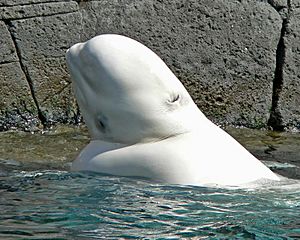
Like most whales with teeth, belugas have a special organ in their forehead called a melon. This melon contains fatty tissue and is used for echolocation. The beluga's melon is very round and noticeable. It can change shape when the whale makes sounds. Belugas can move air around their sinuses to focus the sounds they send out.
Unlike many dolphins, belugas have neck bones that are not joined together. This allows them to turn their head from side to side. This helps them see better and move easily in deep water. It also helps them catch prey and avoid predators. Belugas have about 8 to 10 small, blunt teeth on each side of their jaw. They have a total of 36 to 40 teeth. They don't chew their food. Instead, they grab prey, tear it up, and swallow it almost whole.
Belugas have one blowhole on top of their head, behind the melon. It has a muscular cover that can seal it completely. A beluga's thyroid gland is very large. It helps them keep a high metabolism during summer when they live in river mouths.
Fins of the Beluga Whale
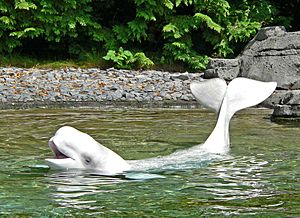
Beluga fins have bones, like their land mammal ancestors. The fins are small, rounded, and shaped like oars. They are slightly curled at the tips. These fins help the beluga steer and move easily in shallow water. The fins also help control body temperature. Arteries that feed the fin muscles are surrounded by veins. These veins can expand or shrink to gain or lose heat.
The tailfin is flat with two paddle-like parts. It has no bones and is made of tough, fibrous tissue. The tailfin has a unique curve on its lower edge. Muscles in the back move the tailfin up and down. This also helps with temperature control.
Belugas do not have a dorsal fin (the fin on the back). Instead, they have a hard ridge. The name apterus means "wingless" in Greek, referring to this. Not having a dorsal fin helps them move under ice. It also helps them save body heat. This ridge, along with their head, can be used to make holes in ice up to 8 cm (3.1 in) thick.
Beluga Whale Senses
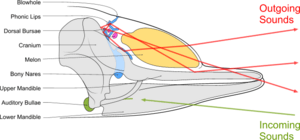
Belugas have excellent hearing. They can hear sounds from 1.2 to 120 kHz. Their best hearing is between 10 and 75 kHz. For comparison, humans hear from 0.02 to 20 kHz. They likely receive most sounds through their lower jaw. A fatty area in the jaw connects to the middle ear. Belugas also have tiny ear holes behind their eyes.
Belugas can see both in and out of water. Their underwater vision is good, but not as sharp as dolphins. Their eyes adjust to see clearly in water. They have cells in their eyes that help them see in low light. This also suggests they might see colors, but this is not confirmed. Glands in their eyes make an oily substance. This substance lubricates the eye and washes out foreign objects. It also protects the eye from germs.
Studies of belugas in aquariums show they like to touch each other. They may have taste receptors in their mouths. They can detect blood in water and react with alarm. Like other whales with teeth, belugas do not have a sense of smell.
Beluga Whale Behavior
Belugas are very social animals. They often form small groups called pods, with 2 to 25 whales, usually around 10. These pods are not always stable; whales often move between groups. Belugas can travel hundreds of miles in just a few days. Pods include both males and females, led by a dominant male. Hundreds or even thousands of belugas can gather in river mouths during summer. This makes them very easy targets for hunters.
Belugas work together, often hunting in groups. They are very playful. They chase each other, rub against each other, and seem to play-fight.
In aquariums, belugas are always playing, vocalizing, and swimming around. They are very curious about humans. They often come to tank windows to watch people. Belugas might even playfully spit water at humans or other whales. Some researchers think spitting started from blowing sand away to find food on the seabed.
In the wild, belugas are also curious about humans. They often swim next to boats. They play with objects they find, like wood, plants, dead fish, and bubbles. During breeding season, adult belugas have been seen carrying objects on their heads and backs. These objects include plants, nets, and even a dead reindeer skeleton. Females in captivity have done this after losing a calf. Experts think this might be a way for them to cope.
Swimming and Diving
Belugas swim slower than other whales with teeth, like killer whales. This is because their bodies are less streamlined. They usually swim between 3 and 9 km/h (1.9 and 5.6 mph). They can swim at 22 km/h for up to 15 minutes. Unlike most whales, they can swim backward. Belugas spend only 5% to 10% of their time on the surface. They do not jump out of the water like dolphins.
Belugas usually dive to about 20 m (66 ft). However, they can dive much deeper. Captive belugas have been recorded diving to 400 to 647 m. Wild belugas have dived over 700 m, with the deepest recorded dive at 872 m. A typical dive lasts 3 to 5 minutes, but can be up to 18 minutes. In shallow river mouths, dives are shorter, around two minutes. They do five or six quick, shallow dives, then one deeper dive for about a minute. They average 31 to 51 dives per day.
All whales, including belugas, have special body features to save oxygen underwater. When they dive, their heart rate drops from 100 beats per minute to 12 to 20. Blood flow is sent mostly to the brain, heart, and lungs, which need constant oxygen. Their blood holds more oxygen than land mammals. Beluga muscles also have high levels of a protein called myoglobin. This protein stores oxygen in the muscles. This helps prevent oxygen shortage during dives.
Beluga whales often swim with bowhead whales. They do this out of curiosity. Bowheads can break through ice with their heads, creating breathing holes for both species.
What Do Beluga Whales Eat?
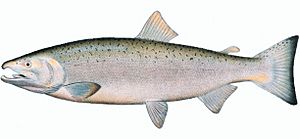
Belugas are important in the Arctic Ocean's food web. They are the most common whales with teeth in the area. They eat whatever food is available, depending on where they are and the season. For example, in the Beaufort Sea, they mainly eat Arctic cod. Belugas near Greenland eat rose fish, Greenland halibut, and northern shrimp. In Alaska, their main food is Pacific salmon.
Generally, belugas mostly eat fish. Other fish they eat include capelin, smelt, sole, flounder, herring, and sculpin. They also eat many invertebrates like squid, crabs, clams, octopus, sea snails, and bristle worms. Belugas in aquariums eat 2.5% to 3.0% of their body weight daily. This is about 18.2 to 27.2 kg of food.
They usually search for food on the seabed at depths of 20 to 40 m. But they can dive to 700 m for food. Their flexible necks help them search the ocean floor. Some belugas suck up water and then forcefully push it out. This uncovers prey hidden in the mud. Their teeth are not big or sharp. So, belugas use suction to pull prey into their mouths. They must swallow their prey whole, so it can't be too big.
Belugas also hunt together in groups of five or more. They herd schools of fish into shallow water. Then, the belugas attack them. For example, in the Amur River estuary, groups of six or eight belugas surround salmon schools. They take turns feeding on the fish.
Beluga Whale Reproduction
Beluga whales reach sexual maturity at different ages. Males are usually ready to breed between four and seven years old. Females are ready between four and nine years old. Females usually have their first calf at 8.5 years old. Their ability to have calves starts to decrease after age 25. No births have been recorded for females older than 41.
Female belugas typically give birth to one calf every three years. Most mating happens from February to May, but it can occur at other times. Pregnancy lasts about 12 to 14.5 months. Some captive females suggest it can be longer, up to 15.8 months.
Calves are born over a long period, depending on the location. In the Canadian Arctic, calves are born from March to September. In Hudson Bay, most births are in late June. In Cumberland Sound, most are born from late July to early August. Births usually happen in warm bays or river mouths, where the water is 10 to 15 °C. Newborns are about 1.5 m (4.9 ft) long and weigh about 80 kg (180 lb). They are grey.
Calves can swim with their mothers right after birth. They nurse underwater, starting a few hours after birth. They feed about every hour. Studies show that a mother's milk changes over time. It has about 28% fat, 11% protein, and 60.3% water. The milk contains about 92 cal per ounce.
Calves depend on their mothers for milk for the first year. Their teeth appear around this time. After that, they start eating shrimp and small fish. Most calves continue nursing until they are 20 months old. Sometimes, they nurse for more than two years. Other females, not the mother, have been seen caring for and even producing milk for calves in captivity. This suggests such "alloparenting" might happen in the wild, too.
Communication and Echolocation
Belugas use sounds and echolocation to move around, communicate, find breathing holes in ice, and hunt in dark or cloudy water. They make fast clicking sounds. These sounds go through their melon, which acts like a lens. It focuses the sounds into a beam that travels forward in the water. These sounds travel almost 1.6 km per second in water. That's four times faster than sound in air!
The sound waves bounce off objects in the water. They return as echoes that the beluga hears and understands. This helps them figure out the distance, speed, size, shape, and even the inside of objects. They also use this when moving through thick Arctic ice. It helps them find open water to breathe or air pockets under the ice.
Belugas are very sensitive to human noise pollution. In one study, a beluga in San Diego Bay made sounds between 40 and 60 kHz. When moved to Kāneʻohe Bay in Hawaii, the same whale made sounds up to 100 to 120 kHz. Scientists think this change in frequency was a response to different noise levels in the two areas.
Belugas communicate using high-frequency sounds. Their calls sometimes sound like bird songs. This is why they are nicknamed "canaries of the sea." Like other whales with teeth, belugas don't have vocal cords. They likely make sounds by moving air between nasal sacs near their blowhole.
Belugas are among the most vocal whales. They use their sounds for echolocation, mating, and communication. They have a wide range of sounds, including cackles, whistles, trills, and squawks. They also make sounds by grinding their teeth or splashing. However, they rarely use body language, like slapping their fins or jumping, as dolphins do.
Where Do Beluga Whales Live?
Belugas live in cold Arctic and sub-Arctic waters around the North Pole. In summer, they are mostly found in deep waters between 76°N and 80°N. This includes the coasts of Alaska, northern Canada, western Greenland, and northern Russia. The southernmost beluga groups live in the St. Lawrence River in the Atlantic. They also live in the Amur River delta, the Shantar Islands, and around Sakhalin Island in the Sea of Okhotsk.
Beluga Whale Migration
Belugas follow a seasonal migration pattern. When their summer homes freeze in autumn, they move to open sea areas. They stay near the edge of the pack ice or in ice-covered areas. They survive by using polynyas (openings in the ice) to breathe. In summer, after the ice melts, they move to shallower coastal waters (1–3 m deep). Sometimes they go to deeper waters (>800 m).
In summer, they live in estuaries and on the continental shelf. Sometimes, they even swim up rivers. There have been reports of belugas found hundreds or thousands of kilometers from the ocean. For example, in 2006, a young beluga was found in the Tanana River in central Alaska. This was almost 1,700 kilometers (1,100 mi) from the nearest ocean. Belugas sometimes follow migrating fish, like salmon, up rivers.
Rivers they often travel up include: the Northern Dvina, Mezen River, Pechora, Ob, and Yenisei in Asia. In Alaska, they use the Yukon River and Kuskokwim River. In Canada, they use the Saint Lawrence River. Spending time in rivers helps their bodies and skin. Rivers are also safe places for newborn calves, away from killer whales. Calves often return to the same river mouth as their mothers in summer, even after they are grown.
Beluga migration is quite predictable. It's mostly decided by how much daylight there is, not by other factors like ice conditions. Some belugas wander further south to places like Ireland, Scotland, and Japan. Rarely, they can even reach the Korean Peninsula.
Some beluga groups do not migrate. They stay in specific areas, like Cook Inlet, the Saint Lawrence River estuary, and Cumberland Sound. The Cook Inlet group stays in the inner waters during summer and autumn. In winter, they spread out to deeper water in the center of the inlet, but they don't leave it completely.
In April, belugas from the Bering Sea move to the north coast of Alaska and eastern Russia. Whales from Ungava Bay and Hudson Bay spend winter together under the ice in Hudson Strait. Belugas from the White Sea, Kara Sea, and Laptev Sea winter in the Barents Sea. In spring, these groups split up and go to their summer homes.
Beluga Whale Habitat
Belugas live in many different places. They are most often seen in shallow coastal waters. But they also live for long periods in deeper water, where they feed and give birth.
In coastal areas, they can be found in coves, fjords, canals, bays, and shallow, sunny parts of the Arctic Ocean. In summer, they are often in river estuaries. Here, they feed, socialize, and have their young. These waters are usually 8 to 10 °C. The mudflats of Cook Inlet in Alaska are a popular summer spot for belugas.
In the eastern Beaufort Sea, female belugas with young and young males prefer open waters near land. Adult males live in ice-covered waters near the Canadian Arctic Archipelago. Younger males and females with older young are found closer to the ice edge. Generally, using different habitats in summer depends on food, predators, and breeding needs for each group.
Beluga Whale Populations
The world's beluga population is made up of many smaller groups. The International Whaling Commission recognizes 29 of these groups.
|
1. Cook Inlet |
9. Frobisher Bay |
18. Svalbard |
26. Western Chukchi Sea |
It's hard to count beluga populations accurately. This is because some groups live in the same areas or move through them at different times. In 2008, the IUCN estimated the world beluga population was well over 150,000.
Threats to Beluga Whales
Hunting Belugas
Native people in the Canadian, Alaskan, and Russian Arctic hunt belugas. They use the meat, blubber (fat), and skin. Beluga skin is thick enough to be used as leather. Belugas were easy to hunt because they followed predictable migration paths. Also, many gathered in river mouths and coastal areas in summer.
Commercial whaling by Europeans and Americans in the 1700s and 1800s reduced beluga numbers in the Canadian Arctic. Whalers hunted them for meat and blubber. Europeans used oil from the melon as a lubricant for clocks and machinery. It was also used for lighting in lighthouses. Mineral oil replaced whale oil in the 1860s. But beluga hunting still continued.
In the 1920s, fishermen in the Saint Lawrence River thought belugas were a threat. They believed belugas ate too many cod, salmon, and other fish. So, in 1928, the Government of Quebec offered a $15 reward for each dead beluga. The killing continued into the 1950s. Later, it was found that belugas did not harm fish populations as much as thought.
Today, native people in the Arctic still hunt belugas for food and materials. This is part of their culture. But there are concerns about whether the number of whales killed is sustainable. About 200 to 550 belugas are killed in Alaska each year, and around 1,000 in Canada. In areas like Cook Inlet, Ungava Bay, and western Greenland, past commercial whaling has endangered the species. Continued hunting by native peoples might cause some populations to keep shrinking. Canada is working with local communities to allow hunting that doesn't risk the species' survival.
Predators of Belugas
In winter, belugas often get trapped in ice. They can't escape to open water, which might be miles away. Polar bears take advantage of this. They can smell belugas and drag them onto the ice to eat them. Bears can catch very large belugas this way. One bear weighing 150 to 180 kg caught a beluga that weighed 935 kg!
Killer whales also hunt both young and adult belugas. They live in all oceans and share the same habitat as belugas in the sub-Arctic. Attacks on belugas by killer whales have been reported in Greenland, Russia, Canada, and Alaska. Many killings have happened in Cook Inlet. Experts worry that killer whale attacks will stop this beluga group from recovering. Killer whales arrive in early August. Belugas can sometimes hear them and escape. Beluga groups near or under sea ice are safer. Killer whales have large dorsal fins (up to 2 m long), which make it hard for them to move under the ice. This stops them from getting close to breathing holes.
Pollution Threats
Belugas are good "sentinel species." This means they show the health of the environment. They live long, are at the top of the food chain, have lots of fat, and are well-studied.
Human pollution can harm belugas, especially when they gather in river mouths. Chemicals like DDT and heavy metals like lead, mercury, and cadmium have been found in belugas from the Saint Lawrence River. Dead belugas from this area have so many pollutants that they are treated as toxic waste. High levels of PCBs (240 to 800 ppm) have been found in beluga brains, livers, and muscles. Males often have the highest levels. These levels are much higher than in Arctic belugas.
These substances are known to harm belugas. They can cause cancers, reproductive problems, and weaken the immune system. This makes belugas more likely to get pneumonia, ulcers, cysts, tumors, and bacterial infections. Even belugas in the open sea have high levels of zinc, cadmium, mercury, and selenium in their bodies.
A study of 129 adult belugas from the Saint Lawrence River found that 27% had cancer. This is a very high percentage. It's higher than in other beluga groups and most land mammals. It's similar to cancer rates in humans and some pets. For example, the rate of intestinal cancer in these belugas is much higher than in humans. This is thought to be linked to pollution, like polycyclic aromatic hydrocarbons. It matches high cancer rates in humans living in the same area. The presence of tumors suggests pollutants are causing cancer or weakening the immune system.
Indirect human activity also poses a threat. While some belugas tolerate small boats, most avoid ships. Whale-watching is popular in the St. Lawrence and Churchill River areas. Noise from these boats seems to affect belugas. For example, beluga crossings at the mouth of the Saguenay River have dropped by 60%. This matches an increase in recreational motorboats. Belugas also make fewer calls (from 3.4-10.5 calls/min to 0 or <1) after being exposed to ship noise. Larger ships, like ferries, have a stronger and longer-lasting effect. Belugas can detect large ships (like icebreakers) up to 50 km away. They quickly move away from them, sometimes following the ice edge for up to 80 km. Ship presence makes belugas change their behavior. They dive deeper for food, groups break up, and their dives become out of sync.
Diseases in Belugas
Like all animals, belugas can get sick and die from different germs. These include viruses, bacteria, protozoans, and fungi. These mainly cause skin, gut, and breathing infections.
Viruses have been found in the stomachs of Saint Lawrence River belugas. These whales have also had herpesvirus infections. Some have even suffered brain infections from a protozoan called Sarcocystis.
A bacterium called Erysipelothrix rhusiopathiae can harm captive belugas. It likely comes from eating infected fish. It causes loss of appetite, skin spots, and lesions. This can lead to a serious blood infection. If not treated quickly with antibiotics, it can cause death.
Studies of belugas have found different types of parasitic worms. These worms can live in their stomachs, intestines, ear canals, and other body parts.
Belugas and Humans
Belugas in Aquariums
Belugas were among the first whales kept in aquariums. The first beluga was shown in New York City in 1861. For most of the 1900s, Canada was the main source of belugas for aquariums. They were taken from the St. Lawrence River estuary and the Churchill River estuary. This stopped in 1992 when the practice was banned. Since then, Russia has become the largest supplier. Belugas are caught in the Amur River delta and eastern Russian seas. They are then sent to aquariums in Russia or exported to other countries, including Canada.
Today, belugas are still one of the few whale species kept in aquariums and marine parks. As of 2006, there were 30 belugas in Canada and 28 in the United States. 42 deaths in captivity had been reported by that time. A single beluga can be worth up to US$100,000. Belugas are popular with visitors because of their white color and many "facial expressions." Unlike most whales, belugas can move their heads more. This allows them to show a greater range of expressions.
To keep them happy in captivity, aquariums train belugas. They perform behaviors for the public and for medical exams, like blood tests. They also get toys, and people can play music for them.
Most belugas in aquariums are caught in the wild. Breeding programs in captivity have not been very successful yet. For example, by 2010, only two male whales had successfully fathered calves in North American aquariums. One male, Nanuq, fathered 10 calves, with five surviving. Another male, Naluark, fathered four living offspring. The first beluga calf born in a European aquarium was in Valencia, Spain, in 2006. Sadly, it died 25 days later. A second calf was born there in 2016 and was successfully raised with artificial feeding.
From 1960 to 1992, the United States Navy studied marine mammals' echolocation. They wanted to improve finding underwater objects. They started with dolphins, but many belugas were also used from 1975 on. The program trained these mammals to carry equipment to divers, find lost objects, watch ships and submarines, and monitor underwater areas with cameras. The Russian Navy had a similar program during the Cold War. They trained belugas for tasks like finding underwater mines in Arctic waters.
In 2009, a captive beluga saved a diver's life in China. During a free-diving competition, a diver got a cramp and was paralyzed at the bottom of a pool. The beluga brought her to the surface by holding her foot in its mouth.
Whale Watching
Whale-watching has become an important activity for towns near the Saint Lawrence and Churchill Rivers. The best time to see belugas is in summer. This is when many gather in river mouths and their summer homes. They are easy to see because there are so many, and they are curious about humans.
However, boats can be a threat to the whales. They distract belugas from important activities like feeding, socializing, and breeding. Also, noise from boat motors can harm their hearing. It reduces their ability to find prey, communicate, and navigate. To protect belugas during whale-watching, the US National Oceanic and Atmospheric Administration has a guide. It recommends boats stay far from whales. It also strictly forbids chasing, bothering, blocking, touching, or feeding them.
Some belugas regularly migrate into the Sea of Japan. For example, in Rudnaya Bay, diving with wild belugas has become a popular activity.
Belugas Mimicking Human Speech
Male belugas in captivity can copy the sounds of human speech. They make sounds several octaves lower than typical whale calls. It's not the first time a beluga has sounded human. They often sound like shouting children in the wild. One captive beluga heard divers using an underwater communication system. It imitated their order to get out of the water, causing a diver to surface. Later recordings confirmed the beluga was good at copying human speech patterns and frequencies. After several years, this beluga stopped making these sounds.
Beluga Whale Conservation Status
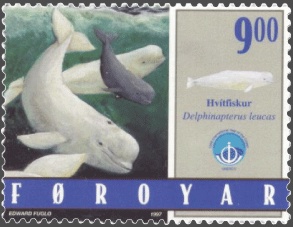
As of 2008, the IUCN lists the beluga as "near threatened." This is because there's some uncertainty about threats to their numbers. Also, the number of belugas in parts of their range (especially the Russian Arctic) is unclear. The IUCN expects that if current conservation efforts, like hunting management, stop, the beluga population might become "threatened" within five years. Before 2008, the beluga was listed as "vulnerable," which is a higher level of concern. The IUCN changed the status because the largest beluga groups are stable. Also, better counting methods showed there were more belugas than previously thought.
Images for kids
See also
 In Spanish: Beluga para niños
In Spanish: Beluga para niños



